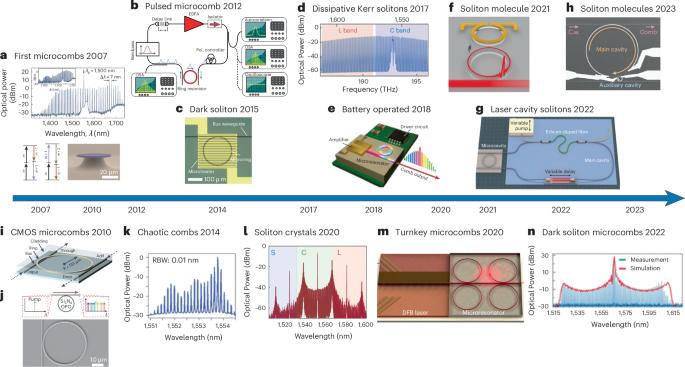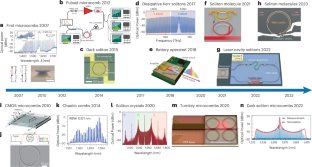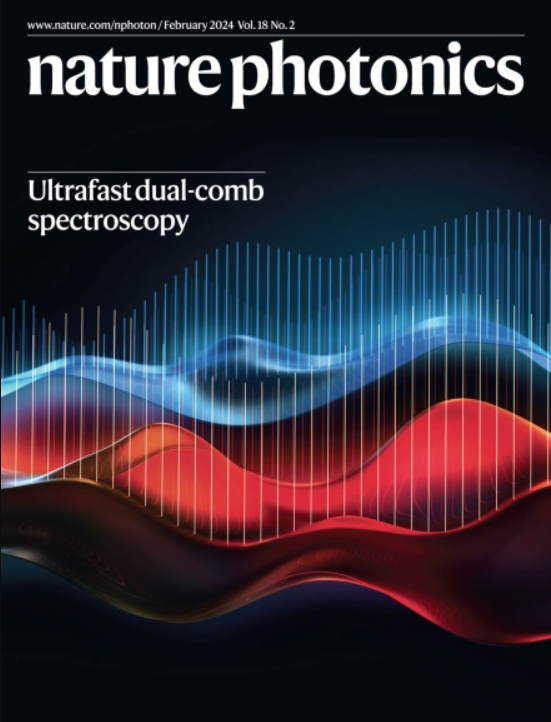用于超高带宽通信的光学微梳
IF 32.9
1区 物理与天体物理
Q1 OPTICS
引用次数: 0
摘要
microcomb -由非线性集成微腔谐振器产生的光学频率梳-具有提供其台式同行的全部功能的潜力,但在集成的足迹中。他们在光谱学、微波光子学、频率合成、光学测距、量子源、计量学、光学神经形态处理等方面取得了突破。它们最成功的应用之一是光纤通信,它们为大规模并行超高容量多路数据传输奠定了基础。近年来,创新的方法被用于锁相或锁模不同类型的微梳,从耗散克尔孤子到暗孤子、孤子晶体等,这使得它们成为先进的相干调制格式光通信系统的来源,这些系统已经实现了超高的数据容量比特率,打破了每秒千兆比特的屏障。在这里,我们回顾了这个令人兴奋的新领域,记录了进展,并强调了挑战和机遇。本文章由计算机程序翻译,如有差异,请以英文原文为准。


Optical microcombs for ultrahigh-bandwidth communications
Microcombs—optical frequency combs generated by nonlinear integrated microcavity resonators—have the potential to offer the full capability of their benchtop counterparts, but in an integrated footprint. They have enabled breakthroughs in spectroscopy, microwave photonics, frequency synthesis, optical ranging, quantum sources, metrology, optical neuromorphic processing and more. One of their most successful applications is in optical-fibre communications, where they have formed the basis for massively parallel ultrahigh-capacity multiplexed data transmission. Innovative approaches have been used in recent years to phase-lock or mode-lock different types of microcombs, from dissipative Kerr solitons to dark solitons, soliton crystals and others, and this has enabled their use as sources for advanced coherent modulation-format optical communications systems, which have achieved ultrahigh data capacity bit rates breaking the petabit-per-second barrier. Here we review this new and exciting field, chronicling the progress and highlighting the challenges and opportunities. This Review summarizes the recent progress in ultrahigh-bandwidth optical-fibre communications based on integrated optical frequency comb technologies, or integrated Kerr microcombs, highlighting the challenges and opportunities ahead.
求助全文
通过发布文献求助,成功后即可免费获取论文全文。
去求助
来源期刊

Nature Photonics
物理-光学
CiteScore
54.20
自引率
1.70%
发文量
158
审稿时长
12 months
期刊介绍:
Nature Photonics is a monthly journal dedicated to the scientific study and application of light, known as Photonics. It publishes top-quality, peer-reviewed research across all areas of light generation, manipulation, and detection.
The journal encompasses research into the fundamental properties of light and its interactions with matter, as well as the latest developments in optoelectronic devices and emerging photonics applications. Topics covered include lasers, LEDs, imaging, detectors, optoelectronic devices, quantum optics, biophotonics, optical data storage, spectroscopy, fiber optics, solar energy, displays, terahertz technology, nonlinear optics, plasmonics, nanophotonics, and X-rays.
In addition to research papers and review articles summarizing scientific findings in optoelectronics, Nature Photonics also features News and Views pieces and research highlights. It uniquely includes articles on the business aspects of the industry, such as technology commercialization and market analysis, offering a comprehensive perspective on the field.
 求助内容:
求助内容: 应助结果提醒方式:
应助结果提醒方式:


